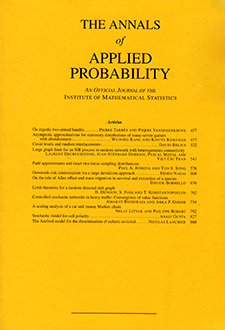Abstract
We consider a random process on recursive trees, with three types of events. Vertices give birth at a constant rate (growth), each edge may be removed independently (fragmentation of the tree) and clusters (or trees) are frozen with a rate proportional to their sizes (isolation of connected component). A phase transition occurs when the isolation is able to stop the growth-fragmentation process and cause extinction. When the process survives, the number of clusters increases exponentially and we prove that the normalised empirical measure of clusters a.s. converges to a limit law on recursive trees. We exploit the branching structure associated to the size of clusters, which is inherited from the splitting property of random recursive trees. This work is motivated by the control of epidemics and contact tracing where clusters correspond to trees of infected individuals that can be identified and isolated. We complement this work by providing results on the Malthusian exponent to describe the effect of control policies on epidemics.
Funding Statement
This work was partially funded by the Chair “Modélisation Mathématique et Biodiversité” of VEOLIA-Ecole Polytechnique-MNHN-F.X and ANR ABIM 16-CE40-0001 and ANR NOLO 20-CE40-0015.
L.Y. acknowledges the support of the National Natural Science Foundation of China (Youth Programme, Grant: 11801458).
Acknowledgments
Parts of this work were finished when C.G. was affiliated to NYU Shanghai.
Citation
Vincent Bansaye. Chenlin Gu. Linglong Yuan. "A growth-fragmentation-isolation process on random recursive trees and contact tracing." Ann. Appl. Probab. 33 (6B) 5233 - 5278, December 2023. https://doi.org/10.1214/23-AAP1947
Information





